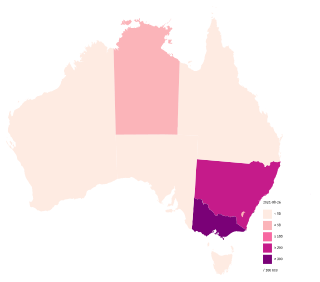
The Cabinet of Australia is the Australian Government's council of senior ministers of the Crown, responsible to Parliament. Ministers are appointed by the Governor-General, on the advice of the Prime Minister, who serve at the former's pleasure. Cabinet meetings are strictly private and occur once a week where vital issues are discussed and policy formulated. The Cabinet is also composed of a number of Cabinet committees focused on governance and specific policy issues. Outside the Cabinet there is an Outer Ministry and also a number of Assistant Ministers, responsible for a specific policy area and reporting directly to a senior Cabinet minister of their portfolio. The Cabinet, the Outer Ministry, and the Assistant Ministers collectively form the full Commonwealth Ministry of the government of the day.

The Council of Australian Governments (COAG) is the "peak intergovernmental forum in Australia". Comprising the federal government, the governments of the six states and two mainland territories and the Australian Local Government Association, it manages governmental relations within Australia's federal system within the scope of matters of national importance.

Jacinda Kate Laurell Ardern is a New Zealand politician who has served as the 40th Prime Minister of New Zealand and Leader of the Labour Party since 2017. She has been the Member of Parliament (MP) for Mount Albert since March 2017, having first been elected to the House of Representatives as a list MP in 2008.
Executive federalism is "the processes of intergovernmental negotiation that are dominated by the executives of the different governments within the federal system." Alternatively, Donald Smiley defined Executive federalism as “the relation between elected and appointed officials of the two orders of government.”

The National Security Committee (NSC), also known as National Security Committee of Cabinet, is the peak decision-making body for national security and major foreign policy matters in the Australian Government. It is a committee of the Cabinet of Australia though decisions of the NSC do not require the endorsement of the Cabinet itself.

The Sixth Labour Government has governed New Zealand since 26 October 2017. It is headed by Labour Party leader and Prime Minister Jacinda Ardern.

The 46th Parliament of Australia is a meeting of the legislative branch of the Australian federal government, composed of the Australian Senate and the Australian House of Representatives. The parliament was opened on 2 July 2019.
The following lists events that happened during 2020 in New Zealand. One overarching event is the coronavirus pandemic.

The first confirmed case relating to the COVID-19 pandemic in Australia was identified on 25 January 2020, in Victoria, when a man who had returned from Wuhan, China, tested positive for SARS-CoV-2.

The first case of COVID-19 in New Zealand during the 2019–20 COVID-19 pandemic was reported on 28 February 2020. As of 9 May 2020, the country has a total of 1,492 cases, of which 103 are currently active, and 21 people have died from the virus. Cases have occurred in all 20 district health board (DHB) areas of the country, and twelve DHBs have active cases as of 7 May 2020.

The COVID-19 pandemic was confirmed to have reached Oceania on 25 January 2020 with the first confirmed case reported in Melbourne, Australia. It has since spread elsewhere in the region, although many small Pacific island nations have thus far avoided the outbreak by closing their international borders. As of 25 April, ten Oceania sovereign states have yet to report a case

The COVID-19 pandemic in Saint Lucia is part of the ongoing global viral pandemic of coronavirus disease 2019 (COVID-19), which was confirmed to have reached Saint Lucia on 13 March 2020. As of 4 May, there are a total of 18 confirmed cases, of which 15 have recovered and no deaths have occurred.

The COVID-19 pandemic in the Bahamas is part of the COVID-19 pandemic of coronavirus disease 2019 (COVID-19). The outbreak was identified in Wuhan, China, in December 2019, declared to be a Public Health Emergency of International Concern on 30 January 2020, and recognized as a pandemic by the World Health Organization on 11 March 2020. It was confirmed to have reached the Bahamas on 15 March 2020 with the announcement of the first case.

The Australian Health Protection Principal Committee (AHPPC) is the peak decision-making committee for public health emergency management and disease control in the Commonwealth of Australia. It is chaired by the Chief Medical Officer of the Australian Government and comprises the Chief Health Officers of the States and Territories. The AHPPC is a principal committee of the Australian Health Ministers' Advisory Council (AHMAC) which supports the Council of Australian Governments (COAG) Health Council.

The National COVID-19 Coordination Commission (NCCC) is a strategic advisory body for the national response to the COVID-19 pandemic by the Australian Government. The NCCC was established on the 25 March 2020 by Prime Minister Scott Morrison to provide advice on public–private partnerships and coordination to mitigate the social and economic impacts of the COVID-19 pandemic in Australia.

Brendan Murphy is Chief Medical Officer of Australia. He has also been Secretary of the Department of Health since 1 March 2020, the first medical doctor to serve as Secretary. He has become "the public face of Australia's fight against COVID-19" during the COVID-19 pandemic in Australia, giving several press conferences with the Prime Minister, Scott Morrison, and Health Minister Greg Hunt.

This article documents the chronology of the response to the COVID-19 pandemic in March 2020, which originated in Wuhan, China in December 2019. Some developments may become known or fully understood only in retrospect. Reporting on this outbreak – since 11 March is called pandemic – began in December 2019.

This article documents the chronology of the response to the COVID-19 pandemic in April 2020, which originated in Wuhan, China in December 2019. Some developments may become known or fully understood only in retrospect. Reporting on this pandemic began in December 2019.

This article documents the chronology of the response to the COVID-19 pandemic in May 2020, which originated in Wuhan, China in December 2019. Some developments may become known or fully understood only in retrospect. Reporting on this pandemic began in December 2019.

The New Zealand budget for fiscal year 2020/21 is set to be presented to the House of Representatives by Finance Minister Grant Robertson on 14 May 2019. This will be the third budget presented by the coalition government of 2017–present. This budget occurs during the COVID-19 pandemic in New Zealand and shortly after Prime Minister Jacinda Ardern is set to announce when the country will exit level 3 lockdown.














